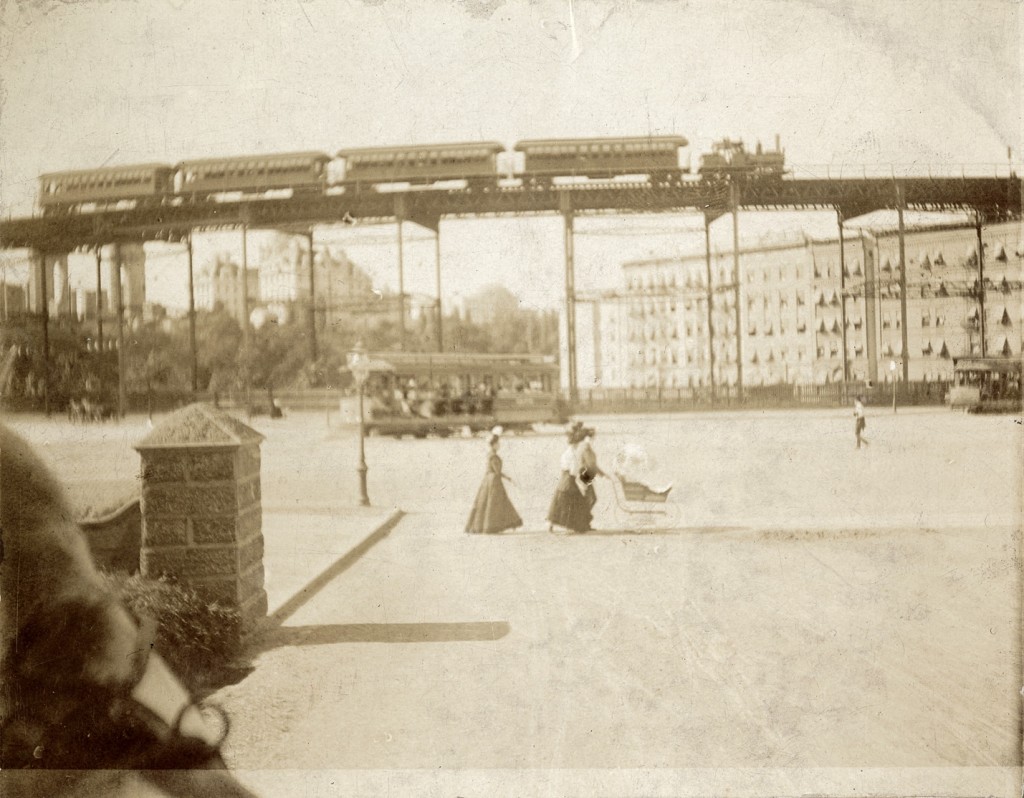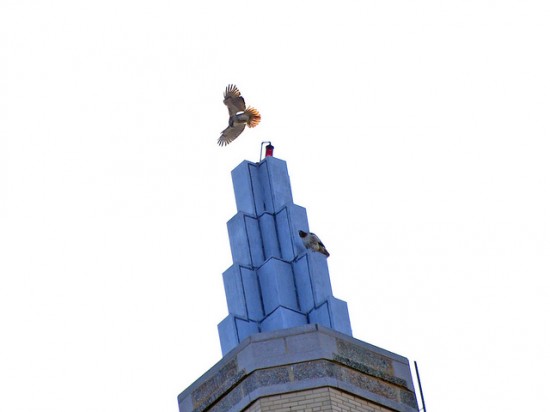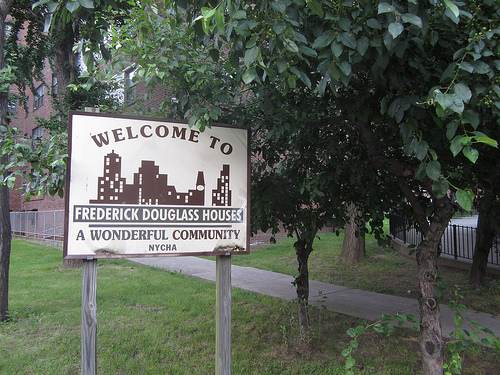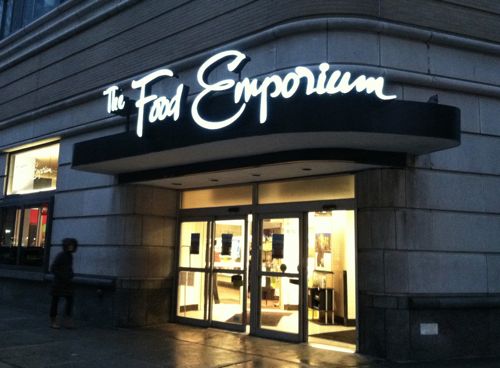
Broadway and 106th street, circa 1890. Image courtesy of New-York Historical Society.
The members of a local history group think that the name of the area from 96th street to 110th, from the river to the park, should be known as Bloomingdale. They want to differentiate this piece of the island from the rest of the Upper West Side, to give the area its own name to evoke its unique past.
The first step in the group’s name change “campaign” was to officially change their own name from The Park West Village Neighborhood History Group to the Bloomingdale Neighborhood History Group. We wanted to know why.
About the History Group
First, a bit of background on the group: It all began in 2000 when Win Armstrong, who has lived in Park West Village (PWV) since 1967, noticed a small item in her building’s newsletter. It asked if anyone had any information on the history of the development, a sprawling urban renewal project of high rises and open space that covers a 20-acre, six block site.
Intrigued by the prospect of knowing more of the back story of her neighborhood, Win organized an informal get-together of like-minded neighbors and the Park West Neighborhood History Group was born. The group’s first program was a panel discussion with people from “the old community”– the people who lived in the vibrant neighborhood that had been torn down to build the PWV development. As Win explains “From that first meeting we realized that something valuable had been lost, that history matters.”
Now the group schedules regular public programs — 150 people recently came out to hear about the history of the Ninth Avenue El (pictured below in a photo looking North up Central Park West from 110th street). In conjunction with the Columbus-Amsterdam BID, they offer neighborhood walking tours of “Old Bloomingdale: Lenape Indians to Obama,” led by history group member Jim Mackin (www.weekdaywalks.com). They also maintain a collection of research and materials relevant to the history of the area at the Bloomingdale Branch of the New York Public Library at 150 West 100th Street.
Why the name change?
For the answer to this question, we went to Jim Mackin:
Q: Why the name Bloomingdale?
A: In the 1600’s, the Dutch named a larger area of the Upper West Side Bloemendaal after a town of the same name in the tulip growing region of Holland. The name means “vale or valley of flowers”. Over time, the name became anglicized to Bloomingdale.
Q: Was the name Bloomingdale always used to represent the area?
A: It’s been used extensively throughout its 300-year history. Bloomingdale was on maps to indicate the community that centered around 99th and 100th Streets along the Bloomingdale Road, near what is now Broadway. In 1821, the Bloomingdale Asylum for the Insane was established in the area and other still extant institutions use the name: the Bloomingdale School of Music, the Bloomingdale branch of the library and the local Bloomingdale public school (PS 145).
Q: Why does the area need a name now?
A: There’s a growing sense that the Bloomingdale neighborhood has its own special identity. It’s a rich mosaic of cultures, people and buildings and its street-level charm distinguishes Bloomingdale from its surrounding neighborhoods. Morningside Heights on the north is renowned for its world-class institutions — Columbia University, Union Theological Seminary, Jewish Theological Seminary, Manhattan School of Music as well as St. Luke’s Hospital, Cathedral of St. John the Divine and Riverside Church. The Upper West Side legacy includes Lincoln Center, the Museum of Natural History, the New-York Historical Society and many luxury apartment buildings, specialty food shops and more. The area we are calling Bloomingdale is a proud part of the Upper West Side but with a more “local” feel.
This is also an area distinguished by having been home to many well-known historical figures. To name just a few: Norman Rockwell, John Coltrane, Theodore Dreiser, Alma Gluck, Alfred A. Knopf, Oscar Hammerstein, John Philip Sousa, Jr., Spencer Tracy, Herman Wouk, Emery Roth, and of course, President Obama.
Q: What about Manhattan Valley?
A: Manhattan Valley is a charming piece of Bloomingdale that centers along Manhattan Avenue from 104th to 110th Streets. Much of Manhattan Valley is distinguished as a Landmarked Historic District.
Weighing in on the new name
We asked some real estate folks what they think of giving the area a new name with historical roots. June Phillips, senior VP at Halstead thinks, “It is a unique area. We never know what to call this neighborhood. Sounds interesting.”
Sharon McIntosh, president of the The McIntosh Company, who once worked for an antiquarian map dealer, likes the idea a lot — “it sounds like good news.”
Peter Arndsten, Manager of the Columbus-Amsterdam Business Improvement District and a member of the History Group, anticipates some push back from “long time residents of Manhattan Valley who have worked to improve that area over the years.” His own opinion is that “the need for a stronger identity for the larger area north of 96th Street makes the historical name both attractive and appropriate.” But, Janet Rosen, an East Sider who is about to move to the West Side, thinks the name is misleading. “When I hear Bloomingdale, I think of the area around the department store. Isn’t that what most people think of?”
For more information on the BNHG
For an up-to-date calendar of the Bloomingdale Neighborhood History Group’s walking tours and presentations, visit www.upperwestsidehistory.weebly.com. (The name of the website has yet to catch up with the name change, but stay tuned.)
For Marjorie Cohen’s ongoing History Beat series in the West Side Rag, click here.
All photos courtesy of New-York Historical Society.











Why if it so historic does it sound like realestate speak:
Bloomingdale Studios with E-I-K price reduced!
Re: “realestate speak”:
That, of course, is what gave us, of course SoHo (for South of Houston), DUMBO (for Down Under the Manhattan Bridge Overpass), and the laughable SpaHa (for “Spanish Harlem” or SoBro (for “South Bronx”)
But there’s not much you can do with one word like Bloomingdale. However, Manhahttan Valley could easily become MaVa. And then realtors could advertise (sorry, Billy Crystal) “Look MaVa-lous in Manhattan Valley”
the Bloomingdale Asylum for the Insane was established in the area and other still extant institutions use the name…..SOUNDS LIKE NYC
Fantastic idea. I agree with the realtors. There are distinct differences between the lower portion of the Upper West Side and the northern end. When people think of the Upper West Side, they are usually thinking of the area between 59th and 96th. It’s time to look at the northern neighborhood differently.
Good luck with that idea. All the mapping companies decided a few years ago that the area btw 96th and 110th is Manhattan Valley, including the area west of Amsterdam. Until you can the source database that feeds them to stop doing that, calling the area Bloomingdale is going to dust in the wind.
Meanwhile there are folks who seem to think that Morningside Heights extends east to Frederick Douglass Blvd. and even beyond. What’s up with that? Fear of using the H word?
The response about the size of the Manhattan Valley Historic District is incorrect. Most people acknowledge MV to be 100th to 110th, CPW to Amsterdam. Within that 10 square block area, only Manhattan Ave. 104th to 105th and a very small portion of 105th and 106th between CPW and Manhattan Ave. as well as CPW between 105th and 106th are part of the historic district. The overwhelming portion of MV is not in an historic district.
I just tried both of the links in the article.
Both bring up a big blank page on the left of the page and the “blogroll” etc on the right.
Pls fix them
I like the idea. As someone who recently moved into 109th between Amsterdam and Broadway, I don’t feel we are in Manhattan Valley (we are not in a valley — that is down the hill towards Central Park) and we are not far enough north to be Morningside Hts. In my mind it is the upper Upper West Side, or the Upper West Side as it used to be. The historic name like the area has charm and authenticity.
Shouldn’t Humphrey Bogart be included among those who have lived in Bloomingdale? One of the numbered streets is subtitled with his name.